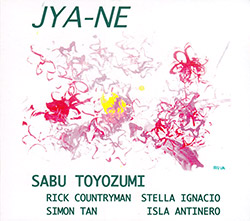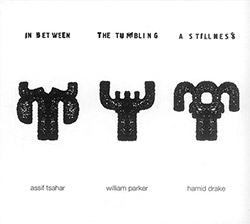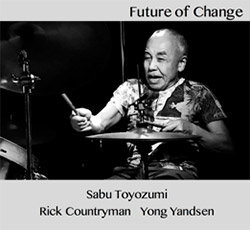![Abe, Kaoru / Sabu Toyozumi: Banka [VINYL] (NoBusiness) Abe, Kaoru / Sabu Toyozumi: Banka [VINYL] (NoBusiness)](https://www.teuthida.com/productImages/misc4/26160.jpg)
NoBusiness continues their essential 70's reissue series of renowned Japanese free improvisers, here in an LP and extended CD edition of the live duo of percussionist Sabu Toyozumi and saxophonist Kaoru Abe on alto, soprano & sopranino saxophones, the LP presenting their 1978 concert at Gaja, Hatsudai in Tokyo, the CD extended with a live set at Minor, Kichijoji the same year.
Out of Stock
Quantity in Basket: None
Log In to use our Wish List
Shipping Weight: 24.00 units
Sample The Album:
Kaoru Abe-sopranino saxophone, soprano saxophone
Sabu Toyozumi-drums, percussion
Click an artist name above to see in-stock items for that artist.
Label: NoBusiness
Catalog ID: NBLP116
Squidco Product Code: 26160
Format: LP
Condition: New
Released: 2018
Country: Lithuania
Packaging: LP
Recorded live at Gaia, Hatsudai, Tokyo, Friday, 13th January, 1978Recorded by Shinji Ohno
"Another reissue from the company NoBusiness has arrived. This time with two musicians I do not initially know who is / where. Kaoru Abe plays all soprano saxophonics and Sabu Toyozumi covers the drums and the percussion. The recordings of these five strings were made in Minor, Kichijôji, and in Gaia, Hatsudai, Tokyo on July 7, 1978 (the first two stretches), and on January 13, the last three.
According to the internet, Abe was a major Japanese avant-garde saxophonist, who specially excelled in Alpha Saxophone. He was self-taught and started at a very young age. He played with drummer Milford Graves and guitarist Derek Bailey, as well as a number of Japanese musicians, especially in free-standing music. He died of a bromisoval overdose in 1978, causing an acute gastric perforation.
Sabu Toyozumi is one of the inovative freejazz musicians in Japan. He played with most of the major Japanese, free-improvising musicians, plus more from the Western countries, such as Derek Bailey, Misha Mengelberg, Peter Brotzmann Tom Cora, John Russell, John Zorn, Evan Parker, Sunny Murray and more.
At a time when it seems that most things are done within creative, improvised music, it's exciting to put on a record of musicians you've never heard before. And this time it was extra special, since the Internet has revealed that there are two of the truly influential Japanese musicians we are going to hear. I have heard a lot of music from the "country of the sun" in recent years, which has either been extremely noisy, or creative almost beyond western ability.
Assuming that this recording was already done in 1978, where even the European freejazzen had not yet completely cleared the roof and flown its own way, it is extremely refreshing to hear this duo. Even today, many are not close to what these two do of free-standing and creative music.
It's almost like hearing a duo recording with Paal Nilssen-Love and Mette Rasmussen. Admittedly, the drummer is not as aggressive and "on" as Nilssen-Love, but when Abu goes away with all soprano saxophones, Rasmussen quickly appears in what is left behind the cerebral cortex.
The first part, called "Song for Mithue Totozumi", is divided into "Part I" and "Part II", which could really be in one, because here is the energetic saxophone game over an extremely violent drum game, with a tight and responsive communication.
Part Two, "Song for Sakamoto Kikuyo" is divided into three sequences, "Part I", "Part II" and "Part III", and starts different from the first strings. Kaoru Abe takes it all the way to the alto saxophone and we are seated like on needles to see where this ends. Toyozami comes in with relatively simple comments on drums, and we get a relatively melancholic song like "Part I".
It reappears in "Part II", but they seem to be in a completely different mood during Gaia recording than they were in Minor. Perhaps it's because the recording is done Friday the 13th? (You never know how such days affect people in Japan). But I feel that this is more in explorer mode than on the second recording. (If you look at the attached video (audio track), which was recorded on April 15th, you can see a development in the collaboration).
But as the recordings are so different in mood, one also gets a variation in the disc that is exciting. But when they enter the fifth and final track of the record, "Part III", they are heading for what we hear on April 15th and July 7th. But it is still a melancholy over "Song for Sakamoto Kikuyo", which is both sore and angry, something Abe is the one who takes the most out.
Taken together, I think the record had a better "development" if the two recordings had been reversed, so Gaia's recording had come first. Then you get an intermediate stage with the video (soundtrack), before it all ends up in the hefty recordings from Minor on July 7th.
But there is a chip ticker in the context. The five tracks we are presented to here are fierce, even though they do not "freak out" equally fiercely all the way. It's creative and exciting, and when you hear Abe in these recordings, it's easy to imagine, for example, the Saxophonist Akira Sakata has picked up some of his inspiration."-Jan Granlie, salt-peanuts.eu
See also the CD edition Mannyoka with additional tracks.Artist Biographies
• Show Bio for Kaoru Abe "Kaoru Abe (阿部 薫 Abe Kaoru) was an influential Japanese avant-garde alto saxophonist. Self-taught at a young age, Abe performed with notables such as Motoharu Yoshizawa, Takehisa Kosugi, Yosuke Yamashita, Derek Bailey, and Milford Graves, although he generally performed solo. He was married to the author Izumi Suzuki, and a cousin to singer Kyu Sakamoto. He was portrayed in Kōji Wakamatsu's film Endless Waltz by punk rock singer Kō Machida. He is not to be confused with the Japanese actor Kaoru Abe. Abe dropped out of highschool in 1967, at 17 years of age, to focus on perfecting his playing, and in 1968, he did his first performance, at a jazz spot named Oreo. In 1970, he met Masayuki Takayanagi. in 1971, he met Izumi Suzuki, and in 1973, they married. In 1976, they had a daughter. However, in 1977, they divorced. Abe was prolific, appearing almost every day to jazz spots and concerts. His library consists almost entirely of archival and live recordings, however he has recorded in a studio. In his later years, Abe would begin playing different instruments. In 1976-1978 to be specific, were his years of most exploration. However there have been instances of him playing harmonica in 1970-1971. He also played bass clarinet all the way throughout his career. Abe died from Bromisoval overdose in 1978, causing a acute gastric perforation." ^ Hide Bio for Kaoru Abe • Show Bio for Sabu Toyozumi "Yoshisaburo "Sabu" Toyozumi (born Tsurumi, Yokohama, 1943) is one of the small group of musical pioneers who comprised the first generation playing free improvisation music in Japan. As an improvising drummer he played and recorded with many of the key figures in Japanese free music including the two principal figures in the first generation, Masayuki Takayanagi and Kaoru Abe from the late 1960s onwards. He is one of a very few of this circle who are still alive and engaged in playing this music today. Toyozumi features on numerous commercially available recordings with many of the most notable Japanese and international improvising musicians including Derek Bailey, Mototeru Takagi, Misha Mengelberg, Peter Brötzmann, Keiji Haino, Otomo Yoshihide, Tom Cora and Fred Van Hove. In 1971 he became the only non-American member of the Association for the Advancement of Creative Musicians(AACM)). He dedicated his first record as a leader, Sabu - Message to Chicago, to compositions by AACM members, and in 1992 toured and recorded with AACM trumpeter Wadada Leo Smith. Toyozumi has been instrumental in bringing many European and American improvisers to Japan including Derek Bailey, Misha Mengelberg and Sunny Murray. In 2005 British improvising guitarist and promoter John Russell arranged a two-day event dedicated to Toyozumi in which the drummer performed in different groupings with 14 musicians from the London improvised music scene including, most notably, Evan Parker, Lol Coxhill, Phil Minton, John Edwards and Steve Beresford. The Wire described his playing at this time as follows: "He's busy, but there's always space between his notes, and he avoids the flashy technical solution to musical problems. His playing is crisp and dramatic, with a very occasional use of repetition to spark a climax. If it's possible for a drum kit to ask awkward questions, Toyozumi seems to be doing it". In an interview with Cadence Magazine in 1988 Toyozumi makes clear the importance of his relationship with nature as an influence on his playing and Clive Bell writing in The Wire in 2005 notes "his devotion to the way of Watazumido, the late shakuhachi player and Zen master, whose performances mixed martial arts and music in a bizarre cocktail of discipline and craziness". In 2009 he returned to London to feature as one of the players in Russell's improvisation festival Fete Quaqua which was recorded for broadcast by BBC Radio 3. He continues to tour widely and in the past year or so has performed in Belgium and France, Chile, Taiwan, England, Philippines and Greece. He also performs from time to time with the legendary Japanese noise group Hijokaidan. Currently he can be found performing on the erhu - a two-stringed Chinese violin - as often as playing the drums." ^ Hide Bio for Sabu Toyozumi
11/20/2024
Have a better biography or biography source? Please Contact Us so that we can update this biography.
11/20/2024
Have a better biography or biography source? Please Contact Us so that we can update this biography.
Track Listing:
SIDE A
1. Song For Sakamoto Kikuyo - Part I 4:43
2 Song For Sakamoto Kikuyo - Part II 14:18
SIDE B
1. Song For Sakamoto Kikuyo - Part III 18:28
Improvised Music
Jazz
Free Improvisation
Asian Improvisation & Jazz
Duo Recordings
Recordings by or featuring Reed & Wind Players
Percussion & Drums
Saxophone & Drummer / Percussionist Duos
Vinyl Recordings
Search for other titles on the label:
NoBusiness.


![Abe, Kaoru / Sabu Toyozumi: Banka [VINYL] (NoBusiness) Abe, Kaoru / Sabu Toyozumi: Banka [VINYL] (NoBusiness)](https://www.teuthida.com/productImages/full/26160.Full.jpg)



















![Guy, Barry / Ken Vandermark: Occasional Poems [2 CDs]](https://www.teuthida.com/productImages/misc4/34849.jpg)
![Novoa / Carter / Mela Trio: Vol.1 [VINYL]](https://www.teuthida.com/productImages/misc4/35236.jpg)


![Elephant9 : Mythical River [VINYL]](https://www.teuthida.com/productImages/misc4/34624.jpg)
![Evans, Peter (Evans / Eldh / Black): Extra [VINYL]](https://www.teuthida.com/productImages/misc4/35279.jpg)

![McPhee, Joe: Straight Up, Without Wings [BOOK]](https://www.teuthida.com/productImages/misc4/35454.jpg)
![Jeck, Philip: rpm [2 CDs]](https://www.teuthida.com/productImages/misc4/35455.jpg)













![Barker / Parker / Irabagon: Bakunawa [VINYL]](https://www.teuthida.com/productImages/misc4/35533.jpg)
![Blaser, Samuel / Marc Ducret / Peter Bruun: Dark Was The Night, Cold Was The Ground [VINYL 10-inch]](https://www.teuthida.com/productImages/misc4/35492.jpg)








![Warren, Kenny (Warren / Hoffman / Ellman): Sweet World [VINYL]](https://www.teuthida.com/productImages/misc4/35451.jpg)




![Blake, Ran / Dave Knife Fabris: Live Amsterdam 2006, First Visit [CD + POSTCARDS]](https://www.teuthida.com/productImages/misc4/35275.jpg)













![DNS: Taking Big Bites Of The Khandas Three Cafes Deep [2 CDs]](https://www.teuthida.com/productImages/misc4/35334.jpg)




![Cleaver, Gerald: The Process [VINYL]](https://www.teuthida.com/productImages/misc4/34966.jpg)




![Alva Noto: HYbr:ID II [VINYL 2 LPs]](https://www.teuthida.com/productImages/misc4/35201.jpg)

![Baron, Derek / Luke Martin: Distinct and Concealed [CASSETTE + DOWNLOAD]](https://www.teuthida.com/productImages/misc4/35079.jpg)

![Lyle, Erica Dawn : Colonial Motels [CASSETTE + DOWNLOAD]](https://www.teuthida.com/productImages/misc4/35080.jpg)









![Sanna, Claudio: Compositori Sardi Contemporanei II [2 CDs]](https://www.teuthida.com/productImages/misc4/35317.jpg)







![Zurria, Manuel: Fame di Vento [3 CDs]](https://www.teuthida.com/productImages/misc4/35167.jpg)

![Granberg, Magnus / Nattens Inbrott / Skogen: Holde Traume, Kehret Wieder! [2 CDs]](https://www.teuthida.com/productImages/misc4/35038.jpg)
![Frey, Jurg: Outermost Melodie [2 CDs]](https://www.teuthida.com/productImages/misc4/35039.jpg)

![Pavone, Jessica: Reverse Bloom [VINYL]](https://www.teuthida.com/productImages/misc4/34895.jpg)




![Modney (Modney / Wooley / Gentile / Roberts / Pluta / Symthe / ...): Ascending Primes [2 CDs]](https://www.teuthida.com/productImages/misc4/34852.jpg)









![Elephant9 with Terje Rypdal: Catching Fire [VINYL 2 LPs]](https://www.teuthida.com/productImages/misc4/35355.jpg)
![Deerlady (Obomsawin, Mali / Magdalena Abrego): Greatest Hits [VINYL]](https://www.teuthida.com/productImages/misc4/34876.jpg)




![Haino, Keiji: Black Blues [2 CDs]](https://www.teuthida.com/productImages/misc4/35109.jpg)



![Surplus 1980: Illusion of Consistency [CD]](https://www.teuthida.com/productImages/misc4/35069.jpg)
![Staiano, Moe: Away Towards the Light [VINYL + DOWNLOAD]](https://www.teuthida.com/productImages/misc4/35037.jpg)



![Caveira (Gomes / Sousa / Abras / Ferrandini): Ficar Vivo [VINYL]](https://www.teuthida.com/productImages/misc4/34643.jpg)
![Gregg, J. J. / David Van Auken: Lunar Prairie [CD w/ DOWNLOAD]](https://www.teuthida.com/productImages/misc4/34611.jpg)

![Coultrain: Mundus [VINYL]](https://www.teuthida.com/productImages/misc4/32439.jpg)
![Mattin: Songbook #6 [VINYL]](https://www.teuthida.com/productImages/misc4/27317.jpg)
![Punkappella: Wake Up [7-inch VINYL]](https://www.teuthida.com/productImages/misc4/17519.jpg)
![Residents, The: WARNING: UNiNC.: Live And Experimental Recordings 1971-1972 [VINYL 2 LPs]](https://www.teuthida.com/productImages/misc4/31521.jpg)
![Coultrain: Phantasmagoria [VINYL]](https://www.teuthida.com/productImages/misc4/30142.jpg)
![Lennon, Sean Ono: Asterisms [VINYL]](https://www.teuthida.com/productImages/misc4/34517.jpg)

![Coley, Byron: Dating Tips for Touring Bands [VINYL]](https://www.teuthida.com/productImages/misc4/17906.jpg)

![Lost Kisses: My Life is Sad & Funny [DVD]](https://www.teuthida.com/productImages/misc4/lostKissesDVD.jpg)